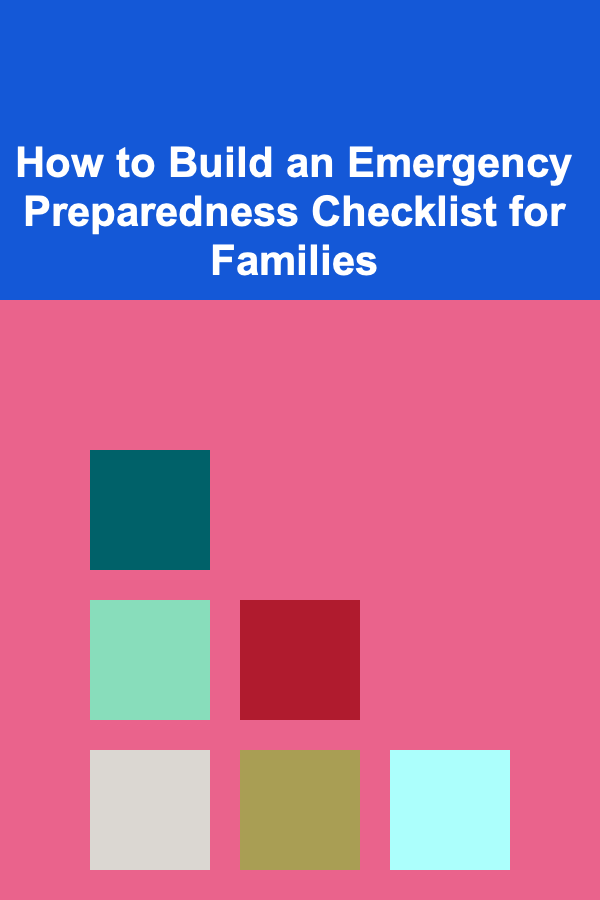
How to Build an Emergency Preparedness Checklist for Families
ebook include PDF & Audio bundle (Micro Guide)
$12.99$5.99
Limited Time Offer! Order within the next:

Emergencies can happen at any time, and being prepared can make all the difference in ensuring your family's safety. Whether it's a natural disaster, a health crisis, or a power outage, having a well-thought-out emergency preparedness checklist is crucial. It not only helps reduce stress during an emergency but also ensures that your family has the supplies and plans needed to navigate a crisis. This comprehensive guide will walk you through how to build a detailed emergency preparedness checklist that's tailored to your family's needs.
Why Is Emergency Preparedness Important?
Being prepared for an emergency is more than just a precaution---it's a vital step in protecting your family and loved ones. The unpredictability of disasters, whether natural or man-made, emphasizes the need to plan ahead. Having an emergency preparedness checklist in place can:
- Reduce Panic: Knowing exactly what to do and what you have on hand can prevent confusion during an emergency.
- Increase Safety: Ensuring you have the necessary supplies and a clear plan can keep your family safe and allow for faster action if needed.
- Save Time: You won't have to waste valuable time looking for supplies or making decisions when time is of the essence.
- Ensure Communication: A communication plan ensures that all family members know how to get in touch if separated.
To start building your family's emergency preparedness checklist, it's essential to cover the basics: supplies, plans, and communications.
Step 1: Assess Risks and Needs
The first step in building your emergency preparedness checklist is assessing the specific risks your family faces. The types of emergencies that may occur vary depending on your location, lifestyle, and resources. By understanding your unique risks, you can better prepare for the most likely scenarios.
Consider Natural Disasters:
- Earthquakes: If you live in an area prone to earthquakes, securing furniture and understanding evacuation routes is critical.
- Floods: If you live in a flood-prone area, a plan for evacuation and a flood emergency kit are essential.
- Hurricanes/Tornadoes: In areas where hurricanes or tornadoes are common, having an evacuation plan and a sturdy shelter in place is vital.
- Wildfires: In regions susceptible to wildfires, a plan to leave early and avoid being caught in dangerous zones is necessary.
Consider Man-Made Disasters:
- Power Outages: In any area, frequent power outages can occur, so having backup generators or other power sources is a good idea.
- Pandemics: In recent times, global health emergencies have made it evident that having a health emergency plan and medical supplies ready is crucial.
- Civil Unrest: While less common, regions experiencing political instability or protests can require additional safety measures.
Consider Your Family's Needs:
- Children: If you have young children, ensure you have age-appropriate supplies and any necessary items like baby formula, diapers, or toys to keep them calm.
- Elderly Family Members: For elderly relatives, ensure medications are stocked, mobility aids are available, and there is a plan for any special health needs.
- Pets: Don't forget to include your pets in the emergency planning. Have pet food, leashes, and crates ready to go in case of evacuation.
Once you've assessed your specific risks and needs, you can begin to customize your emergency preparedness checklist accordingly.
Step 2: Build Your Emergency Supplies Kit
An emergency supplies kit is one of the most crucial elements of any emergency preparedness plan. It should contain all the essentials that your family would need if cut off from regular sources of food, water, and supplies. Below is a comprehensive list of what you should include in your family's emergency kit.
Basic Supplies:
- Water: At least one gallon per person per day for a minimum of three days (for drinking and sanitation).
- Non-perishable Food: Canned goods, dried fruits, nuts, energy bars, and ready-to-eat meals. Aim for a three-day supply.
- Battery-Powered or Hand-Crank Radio: A NOAA Weather Radio with tone alert to stay informed about weather alerts and news.
- Flashlight: LED flashlights or headlamps with extra batteries. Consider solar-powered lights if you're concerned about battery life.
- First-Aid Kit: Include bandages, antiseptic, scissors, tweezers, and any medications your family members may need.
- Whistle: To signal for help if you need to attract attention during an evacuation or rescue situation.
- Face Masks: N95 or similar masks for protection from dust, smoke, or biological hazards.
- Plastic Sheeting & Duct Tape: To seal windows, doors, or rooms in case of contamination or exposure to harmful substances.
Tools and Equipment:
- Multi-Tool or Swiss Army Knife: A versatile tool for all sorts of emergencies.
- Portable Phone Charger: Solar-powered chargers or extra battery packs to ensure your devices stay charged.
- Work Gloves: Heavy-duty gloves to protect hands when handling debris or performing manual tasks.
- Folding Shovel: Useful for digging or moving debris in certain emergency situations.
- Fire Extinguisher: A small, home-size fire extinguisher to put out small fires before they spread.
Personal Hygiene and Sanitation:
- Toilet Paper and Wipes: Essential for sanitation purposes.
- Hand Sanitizer: To reduce the spread of germs when water is unavailable.
- Trash Bags: For waste disposal, especially if you're in a shelter or in a non-standard living situation.
- Feminine Hygiene Products: Don't forget to include sanitary pads or tampons for menstruating family members.
Clothing and Bedding:
- Extra Clothing: Include changes of clothes for each family member, including warm clothes in colder climates.
- Blankets: At least one blanket or sleeping bag per person for warmth, especially in cold weather.
- Rain Gear: Ponchos, waterproof jackets, or umbrellas for wet conditions.
Medications and Medical Needs:
- Prescription Medications: At least a week's supply of any medications your family members are taking.
- Over-the-Counter Medications: Include items like pain relievers, antihistamines, and anti-diarrheal medication.
- Eyeglasses or Contact Lenses: Keep a spare pair of glasses or extra contact lenses if applicable.
Important Documents:
- Copies of Important Documents: Keep copies of identification, insurance policies, medical records, and bank account information in a waterproof container.
- Cash: Small bills and coins in case credit card machines or ATMs are not working.
- Maps: Physical maps in case GPS or internet access is down.
Miscellaneous:
- Toys and Comfort Items for Children: To help keep kids calm during stressful situations.
- Books or Games: Entertainment to pass the time during long waits or in shelters.
- Pet Supplies: Food, water, leash, carrier, and other pet necessities.
- Important Contact Numbers: A list of phone numbers of family members, neighbors, and friends in case of separation.
Check and Maintain Your Kit:
- Rotation: Regularly check the expiration dates on food, medications, and batteries. Replace items as needed.
- Seasonal Adjustments: In colder months, consider adding warm clothing and additional blankets. In summer, add sunscreen and bug repellent.
Step 3: Develop an Emergency Plan
While supplies are critical, so is having a clear and concise emergency plan. This plan should be communicated to all family members and practiced regularly.
Communication Plan:
- Family Contact Information: Ensure all family members have an up-to-date list of contact numbers. Include work, school, and emergency contacts.
- Out-of-Town Contact: Designate an out-of-town family member or friend to be the central point of contact for everyone to check in with in case of separation.
- Emergency Texting: In many cases, texting may work better than calling when phone lines are congested. Make sure everyone knows to send a text if possible.
Evacuation Plan:
- Routes and Destinations: Identify multiple evacuation routes from your home and know where you'll go if you need to evacuate (e.g., relatives' homes, community shelters).
- Meeting Points: Have a designated meeting spot in case you are separated during an evacuation or emergency.
- Vehicle Safety: Make sure your car is in good working order, has a full tank of gas, and is ready for travel in an emergency. Keep an emergency car kit as well.
Special Needs:
- Mobility Aids: Ensure that family members with mobility issues have the necessary equipment (wheelchairs, walkers, etc.).
- Emergency Childcare: If you have young children, ensure there are specific plans in place for childcare during an emergency.
Practice Your Plan:
- Regular Drills: Practice evacuation drills, emergency communication plans, and safety procedures so everyone knows what to do when the time comes.
Step 4: Review and Update Regularly
Emergency preparedness is an ongoing process. Regularly review your emergency plan and supplies to ensure they meet your family's evolving needs.
- Review Annually: Set a date each year to go over your checklist and update supplies.
- Adapt for Changes: If your family grows, moves to a new area, or experiences changes in health needs, revise your plan accordingly.
Conclusion
Building an emergency preparedness checklist for your family is one of the most important steps you can take to ensure your safety during an unexpected crisis. From gathering supplies to developing a comprehensive plan, the effort you put into preparing now can make all the difference in a disaster. Remember, preparedness is an ongoing commitment---stay informed, stay organized, and stay ready. Your family's safety is worth the effort.
Reading More From Our Other Websites
- [Home Lighting 101] How to Use Solar Lighting to Save Energy Outdoors
- [Home Cleaning 101] How to Clean a Garbage Disposal the Right Way: Prevent Odors and Clogs
- [Sewing Tip 101] Must-Have Sewing Notions: Essentials Every Stitcher Needs in Their Toolkit
- [Digital Decluttering Tip 101] From Chaos to Clarity: A Step‑by‑Step Workflow for Digitally Organizing All Your Files
- [Home Soundproofing 101] How to Install Soundproofing Foam Panels for Maximum Effectiveness
- [Home Soundproofing 101] How to Soundproof Your Floors and Prevent Noise from Below
- [Home Pet Care 101] How to Use Pet-Safe Pest Control Methods: Protecting Your Pets and Home
- [Rock Climbing Tip 101] Mental Game Strong: How to Overcome Fear and Stay Focused on the Wall
- [Home Maintenance 101] How to Fix a Running Toilet and Avoid Wasting Water
- [Mindful Eating Tip 101] Best Approaches to Incorporate Mindful Eating into a High‑Intensity Training Nutrition Plan

How to Create a Fun Indoor Scavenger Hunt for the Family
Read More
How to Create a Kitchen Cabinet Organization Strategy
Read More
How to Design a Meeting Preparation Checklist for Client Meetings: An Actionable Guide
Read More
How to Sell Antique Furniture on eBay: A Comprehensive Guide
Read More
How to Get Last-Minute Event Tickets
Read More
How to Automate Your Bill Payments with a Planner
Read MoreOther Products

How to Create a Fun Indoor Scavenger Hunt for the Family
Read More
How to Create a Kitchen Cabinet Organization Strategy
Read More
How to Design a Meeting Preparation Checklist for Client Meetings: An Actionable Guide
Read More
How to Sell Antique Furniture on eBay: A Comprehensive Guide
Read More
How to Get Last-Minute Event Tickets
Read More